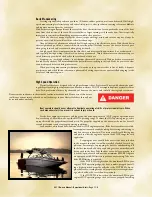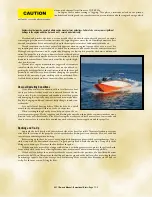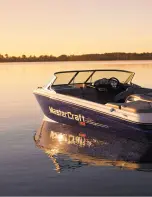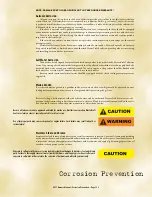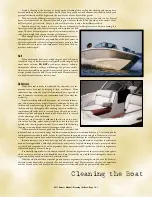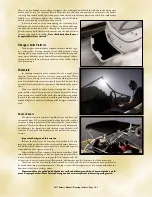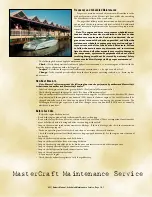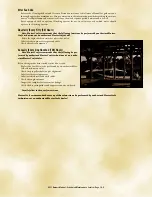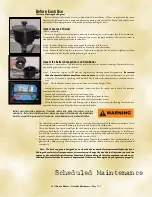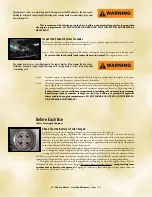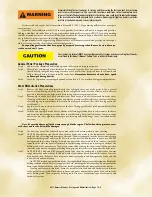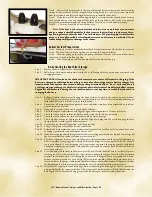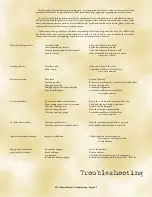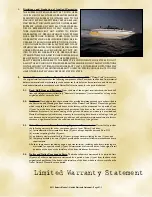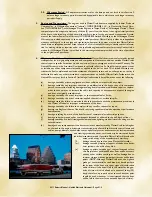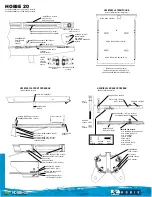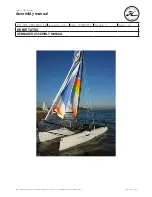
Before Each Use
(Prior to Starting the Engine)
Review the
Safety Checks and Services
section of this Owner’s Manual. There are important functions
that must be followed before, during and after every outing, without fail! The
Safety Checks and Services
notes that all drain plugs must be reinstalled prior to operating the boat!
Inspect Seacock Strainer
(where equipped)
Because a clogged seacock strainer puts undue strain on the engine(s), the strainer should be checked prior
to starting the boat. Boats with closed cooling systems are not equipped with this. The seacock strainer is
standard on boats built for operation in salt water.
Step 1:
Remove the plastic wing nut on top of the strainer. Lift the cover.
Step 2:
Remove the filter and inspect for debris. Manually clean the strainer.
Step 3:
Return the filter in place and recover. Tighten the wing nut, but do not over-tighten as it may
eventually strip the threads holding the wing nut in place.
Inspect the Battery Connections and Hold-Downs
Because poor connections or hold-downs may result in erroneous voltmeter readings, MasterCraft recom-
mends doing this before starting the boat.
Step 1:
Ensure the engine is OFF and the engine safety starting switch disconnected.
Be certain
that the throttle/shift control lever is in neutral.
Locate the battery. Batteries are placed in
a variety of locations, depending on the model. Check under the observer seat or behind the rear
seat.
Step 2:
Check that the battery post connections are clean and tight. If not:
• Loosen and remove the negative terminal connection first. Be careful not to touch the positive
terminal with the wrench.
• Loosen and remove the positive terminal connection.
• Remove the battery hold-downs and remove the battery from the boat.
• Clean corrosion from the battery posts with a battery terminal cleaner.
• Clean the battery with a water-and-baking-soda solution. Use care to avoid allowing the solution to
enter the battery vents. Rinse the battery with fresh water.
2011 Owners Manual...Scheduled Maintenance...Page 17-1
Scheduled Maintenance
Battery electrolyte fluid is dangerous. It contains sulfuric acid, which is poisonous, corrosive
and caustic. If electrolyte fluid is spilled or placed on any part of the human body, immediately
flush the area with large amounts of clean water and immediately seek medical attention.
• Use a battery terminal cleaning brush to remove corrosion from the inside of the battery terminals. Clean
the terminals with a water-and-baking-soda solution and rinse with fresh water.
• Check the battery box that normally holds the battery in place to determine whether there is evidence
of battery fluid inside it. Battery fluids are corrosive and can cause permanent damage to the battery
box. If fluid is evident, wash out the box with the water-and-baking-soda solution that is used in clean-
ing the terminals. Rinse with fresh water and dry with a cloth.
• Reconnect the positive terminal first, then the negative. Tighten the terminals. Coat both terminals com-
pletely with a thin covering of marine grease. Be sure that the rubber boot covers the positive terminal
completely.
Note: The boat’s engine is designed to work with the standard electronics installed in the boat.
Adding other electrical components or accessories can change the way the fuel injection controls the
engine or the overall electrical system functions. Before adding electrical equipment, consult an au-
thorized MasterCraft dealer’s service department. Otherwise, the engine may not perform properly.
Summary of Contents for prostar 190 2011
Page 26: ...Guide to Individual Models 2011 Owners Manual Guide to Individual Models Page 4 1...
Page 81: ......
Page 93: ......
Page 105: ......

